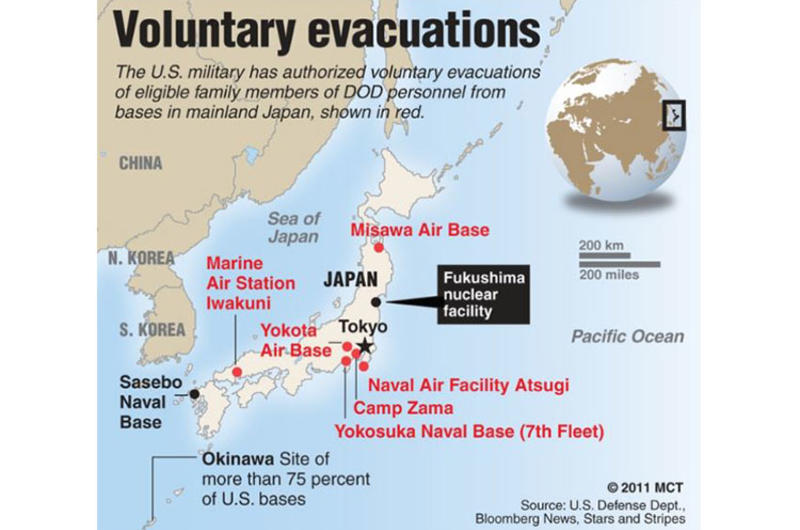

This website was created and maintained from May 2020 to May 2021 to commemorate the 75th anniversary of Stars and Stripes operations in the Pacific.
It will no longer be updated, but we encourage you to explore the site and view content we felt best illustrated Stars and Stripes' continued support of the Pacific theater since 1945.
Military begins voluntary evacuation of families in Japan

By Erik Slavin and Chris Carroll | Stars and Stripes March 17, 2011
YOKOSUKA NAVAL BASE, Japan — The U.S. military authorized voluntary evacuations of eligible family members of Defense Department personnel Thursday from bases in mainland Japan following increasing worries over nuclear reactors damaged in the country’s largest recorded earthquake.
The reactors began failing shortly after Friday’s 9.0 magnitude earthquake.
Officials don’t know how heavy the demand will be, but the potential number of evacuees is in the thousands, Pentagon spokesman Col. David Lapan said. The primary means of evacuation will be commercial airlines and chartered flights, but if the demand is heavy, military aircraft will participate.
However, family members who are visiting servicemembers in Japan, or those living with servicemembers on unaccompanied tours, are not eligible under the order, which covers the cost of the evacuation, Lapan said. Their numbers should be relatively small, he said, though he could not cite specific figures.
“This does not affect U.S. military personnel, does not affect civilian personnel. Only eligible family members,” Lapan said.
He added that the voluntary evacuation was precautionary and that he knew of no elevated radiation measurements at U.S. bases that prompted it.
The evacuations could start Friday morning, Navy officials in Japan said.
At bases across the country, families wrestled with whether to evacuate, splitting their families during the stressful time.
One woman leaving Yokosuka Naval Base’s legal service office late Thursday said she didn’t have time to talk because she had to go take care of her children. When asked how she felt, she simply said, “Terrified,” before walking away.
Others expressed unease, but said they didn’t plan on evacuating unless the order became mandatory.
“I’m trying very hard to stay rational,” said Cathy Schrum, of Orlando, Fla., while eating with her daughter Katie, 2, at the base food court. “If I were to think of evacuating, I would just have to see concrete proof — or I’d go if [command] makes me.
Tara Lyles, who moved to Naval Air Facility Atsugi just two weeks ago, said she wasn’t concerned about the effects of the nuclear reactor damage until she heard news of the pending evacuation. If she goes, she said, at least her husband will be able to do his job without worrying about his family being in harm’s way.
“We were told that there were voluntary evacuations, but I kind of feel it’s not voluntary,” Lyles said. “I just feel we kind of have to go.”
The Navy already has the ability to evacuate as many as 10,000 people per day. If the Navy can secure the additional aircraft, it would be able to bump that number to 18,000 per day.
There are about 25,000 people at Yokosuka Naval Base, roughly 19,000 who are Americans or family members with Defense Department ID cards. There are 6,500 people at Atsugi, though the number of Americans wasn’t immediately available.
“The order of departure: Women and children first, non-essential person second, essential personnel third, and then me,” said Capt. Eric Gardner, Atsugi commander, during a broadcast on the base command channel.
Military officials told families wishing to leave Japan to make sure they have all necessary documents before trying to board the plane.
The documents — known as a Noncombatant Evacuation Operation packet — include:
- Defense Department ID card;
- passport;
- DD 2585 form;
- DD 1337 form, if military;
- DD 2461 form, if civilian;
- household goods inventory;
- record and copy of vehicle registration form.
Naval Facilities Far East commander Capt. Robert McLean told all workers in an e-mail message that “as a prudent action we are going to begin to voluntarily relocate dependents from Yokosuka and Atsugi. Local bases will provide amplifying guidance on priorities, guidelines, mustering locations, etc...
“If you have dependents evacuating, please ensure they have contact numbers.”
Navy facilities workers were told to remain, according to McLean’s e-mail message.
“Again, I am not aware of any change to the current health risk situation in Yokosuka and Atsugi, but due to the ongoing reactor issues, this is a prudent, pre-emptive effort,” McLean said.
Navy officials plan to go door-to-door to hand out bar-coded bracelets which would automatically manifest families, according to command officials involved in the emergency meetings.


